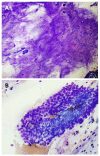Endoscopic ultrasound in the evaluation of pancreatic neoplasms-solid and cystic: A review
- PMID: 25901210
- PMCID: PMC4400620
- DOI: 10.4253/wjge.v7.i4.318
Endoscopic ultrasound in the evaluation of pancreatic neoplasms-solid and cystic: A review
Abstract
Pancreatic neoplasms have a wide range of pathology, from pancreatic adenocarcinoma to cystic mucinous neoplasms. Endoscopic ultrasound (EUS) with or without fine needle aspiration (FNA) is a helpful diagnostic tool in the work-up of pancreatic neoplasms. Its utility in pancreatic malignancy is well known. Over the last two decades EUS-FNA has become a procedure of choice for diagnosis of pancreatic adenocarcinoma. EUS-FNA is highly sensitive and specific for solid lesions, with sensitivities as high as 80%-95% for pancreatic masses and specificity as high as 75%-100%. Multiple aspects of the procedure have been studied to optimize the rate of diagnosis with EUS-FNA including cytopathologist involvement, needle size, suctioning and experience of endoscopist. Onsite pathology is one of the most important elements in increasing diagnostic yield rate in EUS-FNA. EUS-FNA is valuable in diagnosing rare and atypical pancreatic neoplasms including neuroendocrine, lymphoma and metastatic disease. As more and more patients undergo cross sectional imaging, cystic lesions of the pancreas are becoming a more common occurrence and EUS-FNA of these lesions can be helpful for differentiation. This review covers the technical aspects of optimizing pancreatic neoplasm diagnosis rate, highlight rare pancreatic neoplasms and role of EUS-FNA, and also outline the important factors in diagnosis of cystic lesions by EUS-FNA.
Keywords: Endoscopic ultrasound-fine needle aspiration; Pancreatic adenocarcinoma; Pancreatic cysts; Pancreatic neoplasms; Review.
Figures











Similar articles
-
High-resolution endoscopic ultrasound imaging and the number of needle passages are significant factors predicting high yield of endoscopic ultrasound-guided fine needle aspiration for pancreatic solid masses without an on-site cytopathologist.Medicine (Baltimore). 2017 Jan;96(2):e5782. doi: 10.1097/MD.0000000000005782. Medicine (Baltimore). 2017. PMID: 28079803 Free PMC article.
-
Efficacy of endoscopic ultrasound fine needle aspiration in diagnosing the rare (non-adenocarcinoma) tumors of pancreas.Acta Gastroenterol Belg. 2014 Sep;77(3):312-7. Acta Gastroenterol Belg. 2014. PMID: 25509202
-
High risk of acute pancreatitis after endoscopic ultrasound-guided fine needle aspiration of side branch intraductal papillary mucinous neoplasms.Endosc Ultrasound. 2015 Apr-Jun;4(2):109-14. doi: 10.4103/2303-9027.156728. Endosc Ultrasound. 2015. PMID: 26020044 Free PMC article.
-
Role of endoscopic ultrasound-guided fine needle aspiration (EUS-FNA) for diagnosis of solid pancreatic masses.Dig Endosc. 2011 May;23 Suppl 1:29-33. doi: 10.1111/j.1443-1661.2011.01112.x. Dig Endosc. 2011. PMID: 21535197 Review.
-
The Role of Endoscopic Ultrasound in the Diagnosis of Cystic Lesions of the Pancreas.Visc Med. 2018 Jul;34(3):192-196. doi: 10.1159/000489242. Epub 2018 Jun 8. Visc Med. 2018. PMID: 30140684 Free PMC article. Review.
Cited by
-
Endoscopic Ultrasound: Reaching Where Others Can't.Cureus. 2017 Apr 15;9(4):e1169. doi: 10.7759/cureus.1169. Cureus. 2017. PMID: 28516004 Free PMC article.
-
Prospective evaluation of EUS-guided fine needle biopsy in pancreatic mass lesions.Endosc Int Open. 2018 Feb;6(2):E242-E248. doi: 10.1055/s-0043-124078. Epub 2018 Feb 7. Endosc Int Open. 2018. PMID: 29423434 Free PMC article.
-
How to prepare, handle, read, and improve EUS-FNA and fine-needle biopsy for solid pancreatic lesions: The pathologist's role.Endosc Ultrasound. 2017 Dec;6(Suppl 3):S95-S98. doi: 10.4103/eus.eus_71_17. Endosc Ultrasound. 2017. PMID: 29387701 Free PMC article. No abstract available.
-
Endoscopic Ultrasound-Guided Fine-Needle Aspiration of Pancreatic Lesions: A Systematic Review of Technical and Procedural Variables.N Am J Med Sci. 2016 Jan;8(1):1-11. doi: 10.4103/1947-2714.175185. N Am J Med Sci. 2016. PMID: 27011940 Free PMC article. Review.
-
Endoscopic ultrasound-guided fine needle aspiration of pancreatic lesions with 22 versus 25 Gauge needles: A meta-analysis.United European Gastroenterol J. 2017 Oct;5(6):846-853. doi: 10.1177/2050640616680972. Epub 2016 Nov 17. United European Gastroenterol J. 2017. PMID: 29026598 Free PMC article.
References
-
- Helmstaedter L, Riemann JF. Pancreatic cancer--EUS and early diagnosis. Langenbecks Arch Surg. 2008;393:923–927. - PubMed
-
- Jemal A, Siegel R, Ward E, Hao Y, Xu J, Thun MJ. Cancer statistics, 2009. CA Cancer J Clin. 2009;59:225–249. - PubMed
-
- Volmar KE, Vollmer RT, Jowell PS, Nelson RC, Xie HB. Pancreatic FNA in 1000 cases: a comparison of imaging modalities. Gastrointest Endosc. 2005;61:854–861. - PubMed
-
- Dewitt J, Devereaux BM, Lehman GA, Sherman S, Imperiale TF. Comparison of endoscopic ultrasound and computed tomography for the preoperative evaluation of pancreatic cancer: a systematic review. Clin Gastroenterol Hepatol. 2006;4:717–725; quiz 664. - PubMed
-
- Vilmann P, Jacobsen GK, Henriksen FW, Hancke S. Endoscopic ultrasonography with guided fine needle aspiration biopsy in pancreatic disease. Gastrointest Endosc. 1992;38:172–173. - PubMed
Publication types
LinkOut - more resources
Full Text Sources
Other Literature Sources
Research Materials

